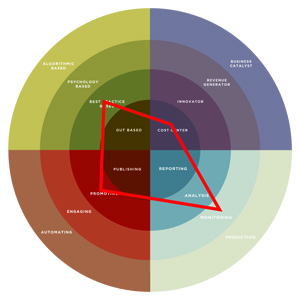
Traditionally, chief marketing officers have had a wide scope of responsibilities ranging from sales to brand management, advertising to customer service, product development to communications. While every organization emphasizes some of these areas more than others, the skills and experience of a CMO must extend into nearly every aspect of a business. And with the introduction of data as a new foundation for marketing strategy, these responsibilities have only grown.
Download now: The Data-Driven CMO Framework

Broadly speaking, CMOs must now master business intelligence, optimization, content and publishing, and resource management. To make matters more complicated, these new categories are not binary—they’re not simple features that can be switched on or off.
Indeed, all four of these categories exist along a continuum. This means that simply measuring a few site metrics or publishing a few blog posts is not enough. Effectiveness in each category can be mapped along scales of complexity and business impact—the more complex, the greater the impact and the better for a business.
And knowing where your organization falls on this scale is critical. It’s not just about getting a score. It’s about identifying strengths and weakness with the goal of creating a roadmap for improvement.
This is why our scorecard isn’t linear. It’s likely that your organization will score higher in one category than the others. Likewise, there will likely be a lowest-scoring quadrant. It’s important perform the assessment honestly and critically. After all, identifying areas for growth is not a problem—it’s an opportunity.
Download our free Data-Driven CMO Framework and find out how you can lead your organization toward more effective strategy.
Categories









